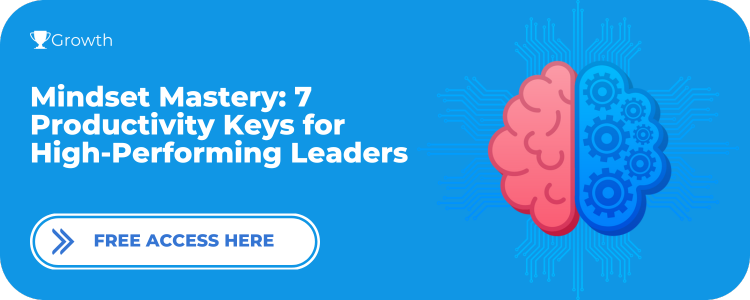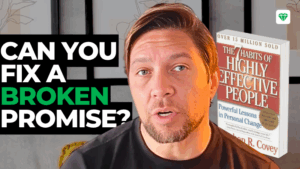✅ FREE ACCESS: Mindset Mastery: 7 Productivity Keys For High-Performing Leaders
Ever wondered how to transform your team into an unstoppable force that thrives in the face of adversity?
Resilience is a critical asset that can make or break the success of a team.
Today, we’re going to learn 3 critical steps to build team resilience for long-term success based on culture, trust, and emotional intelligence.
But before we get into it, make sure you grant your lifetime access to our free Workbook: Mindset Mastery: 7 Productivity Keys for High-Performing Leaders.
This is your chance to make the mindset shift you need to build successful teams using the 7 mindset keys of the 1% top-performing leaders.
1) How to Build Resilience in a Team Through Culture
Team resilience is related to collective strength, determination, and ability to navigate obstacles as a cohesive unit.
A resilient team possesses the power to bounce back from setbacks, and weather storms, emerging stronger than ever before.
So, here are 3 mechanisms to teach you how to build resilience in a team: Culture, Trust, and Emotional Intelligence.
In the book, The Culture Code: The Secrets of Highly Successful Groups, Daniel Coyle sheds light on the fact that resilient teams cultivate an environment where individuals feel supported, valued, and empowered to contribute their best.
So we have to answer 2 questions, here.
- What does a culture that builds team resilience look like?
- How do we build a culture like that?
What a Great Team Culture Looks Like
Resilient teams have 3 fundamental aspects in their workplace culture:
1) A sense of purpose.
2) A sense o belonging.
3) A sense of identity.
A sense of purpose is the idea of moving toward something meaningful and worthwhile.
A sense of belonging is the idea of being part of an environment where people share the same values.
A sense of identity is the idea of building a workplace culture where people feel heard, cared for, and connected.
When you get all 3 cultural aspects, team members are more likely to embrace challenges, learn from setbacks, and work collectively towards their goals.
How to Build a Culture of Team Resilience: Purpose & Belonging.
The sense of purpose and the sense of belonging are built through a coherent hiring process.
In other words, when you have team members that feel unmotivated and detached, that means your hiring process is making 2 big mistakes:
Mistake #1: You are hiring people that you shouldn’t.
Mistake #2: You are not hiring people that you should.
That happens because your hiring process is not considering the psychological profile of the candidates. You are only assessing their skills based on their resumes.
That’s a terrible mistake.
My #1 rule of recruitment is: Hire people first and professionals second.
What does that mean?
It means that you should consider the psychological profile of your candidates as the first filter during the hiring process.
Those who pass through this first stage will be considered professional.
Why is that?
For many reasons, one of them is that it’s easier for you to train a professional to become successful in their position in the company than to coach someone to become aligned with the company’s culture.
Most of the time you will be successful with the first and not so much with the second scenario.
That happens because to become a successful professional in your company, people just need to learn skills. To be a successful member of the tribe, they need a proper set of values they bring from their upbringing.
It’s easier to train someone how to sell than to coach someone how to don’t steal or lie.
That must be filtered during the recruitment process.
And, just to be clear, when I say that you are hiring someone that you shouldn’t, I’m not saying that person is a waste.
I’m saying that there is not a good fit for this specific workplace.
Everybody is competent when playing in the proper field, with a proper team.
Hiring someone that doesn’t have a good cultural fit just because they have a great professional record will make them suffer and prevent them to be hired by another workplace where they could thrive.
How to Build a Culture of Team Resilience: Identity.
The third cultural aspect, the sense of identity, is what you get when employees feel they are part of something they are proud of.
It’s when they see themselves in that workplace in the long run.
They are not quiet quitting.
So, here’s the deal: Good professionals are always growing and they care about their well-being and the well-being of others above financial gains.
Because, guess what, great professionals can pick where they work. They can pick where they make money.
So, a workplace that provides human connection, appreciation, and recognition will be the workplace they pick to be for years.
If those great professionals don’t feel they matter, they won’t feel that the work they do matters and they will try to find that somewhere else.
What should you do as a leader to build a resilient team culture?
You should provide them with a clear pathway for growth, personally and financially.
In the Mindset Mastery Workbook available in the description, I present an effective team management framework to build the dynamics of a resilient culture using Eisenhower Matrices.
2) How to Build Resilience in a Team Through Trust
Trust is the most fundamental component of any relationship. Without trust, there is no team.
As a leader, you can take this checklist of 5 items to assess how your business is building trust among team members.
1) Create Psychological Safety
Think this way:
As a leader, if you downgrade your team’s evaluation because they didn’t reach 100% of their goals, you’re leaving money on the table.
Why?
Because why would they stretch themselves with bold achievements if they can be average and praised by you instead?
Build an environment where team members feel psychologically safe to take risks, share ideas, and express their opinions without fear of judgment.
2) Lead by Example
If you want to build a workplace where team members know they can trust, you need to embody trustworthiness.
As a leader, show that through your actions and decisions. Be transparent, consistent, and reliable. Actively seek feedback from team members and address their concerns.
Leadership is about taking responsibility for lives, not numbers.
3) Encourage Collaboration
Encourage diverse perspectives, active participation, and shared decision-making.
When team members feel heard, supported, and encouraged, trust deepens, fostering a resilient and innovative team culture.
When people work hard to help each other, the chances of failure are virtually zero.
4) Celebrate and Learn from Mistakes
Give your team members the tools, resources, and autonomy they need to succeed.
This means setting clear expectations, providing feedback and guidance, and then stepping back and letting them take ownership of their work.
There will always be a learning curve fueled by mistakes. As a leader, you need to embrace a growth mindset where mistakes are seen as learning opportunities.
Becoming is better than being.
5) Provide Constructive Feedback
What a constructive feedback looks like? If it doesn’t have these traits, whatever you’re doing, it’s not that.
Constructive feedback is timely.
The more time you take to address it, the lesser effective it becomes. having systematic feedback is also a great idea, that would avoid the culture of only providing feedback when something bad happens.
Constructive feedback is specific.
Constructive feedback has numbers, dates, quotes, actions, and decisions made specifically about the item approached.
Great job! You did great! I’m proud of you! Just sounds vague and it means you are not paying attention. You don’t know what happened around you as a leader.
Constructive feedback is developmental.
Constructive feedback, delivered with empathy and respect, builds trust and contributes to the team’s resilience.
Great leaders are willing to sacrifice their interests for the team’s well-being.
By building a team based on trust, you increase the chances of having the best of each team member pushed forward, ultimately resulting in innovative ideas, out-of-the-box solutions, and tipping-point products.
3) How to Build Resilience in a Team Through Emotional Intelligence
Emotional intelligence allows teams to navigate conflicts, resolve disagreements, and build strong relationships.
In his book Emotional Intelligence: Why It Can Matter More Than IQ, Daniel Goleman outlines the impact of emotional intelligence on team dynamics.
He defines emotional intelligence as the ability to recognize, understand, and manage our emotions and the emotions of others.
Although shaped by childhood experiences, emotional intelligence can be nurtured and developed throughout our lives.
Here are 4 factors to develop team resilience through emotional intelligence:
1) Emotional Awareness
Emotional intelligence starts with emotional awareness. If you don’t know what you’re feeling, you don’t know how to act, react, or interact.
Emotionally aware team members can identify and understand their own emotions, as well as recognize the emotions of others.
This awareness allows them to navigate challenges and setbacks with empathy, adaptability, and a solutions-oriented mindset.
2) Open Communication
Team members with an open communication stance can express their thoughts, concerns, and ideas clearly and respectfully.
They also actively listen to others, creating an environment where diverse perspectives are valued.
This open communication promotes trust and collaboration during challenging situations.
3) Conflict Resolution
Conflict resolution means finding common ground, seeking mutually beneficial solutions, and maintaining positive relationships, even in the face of disagreements or adversity.
It’s the idea of “us” instead of “me” and “they.”
- It’s not their fault. It’s our responsibility.
- It’s not my success. It’s our accomplishment.
- It’s not that they didn’t understand. It’s that I couldn’t make myself clear.
4) Team Cohesion and Support
Cohesive and supportive team members can offer support, encourage, and rally the team during difficult times.
This mutual support creates a resilient foundation that helps the team navigate challenges, adapt to change, and stay motivated toward their goals.
Teams that develop emotional intelligence show better conflict-resolution skills, improved team cohesion, and higher levels of resilience in the face of adversity.




